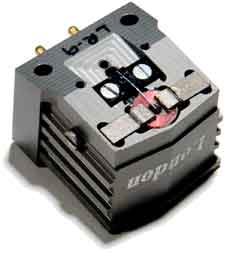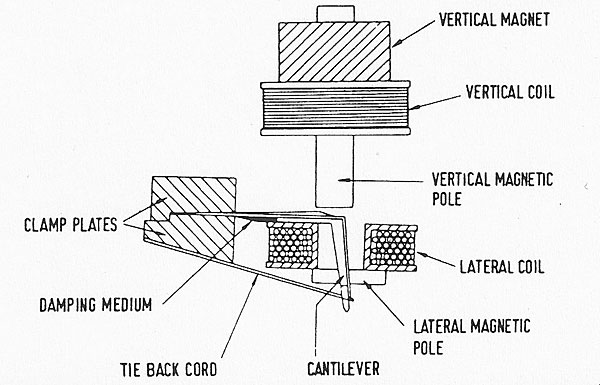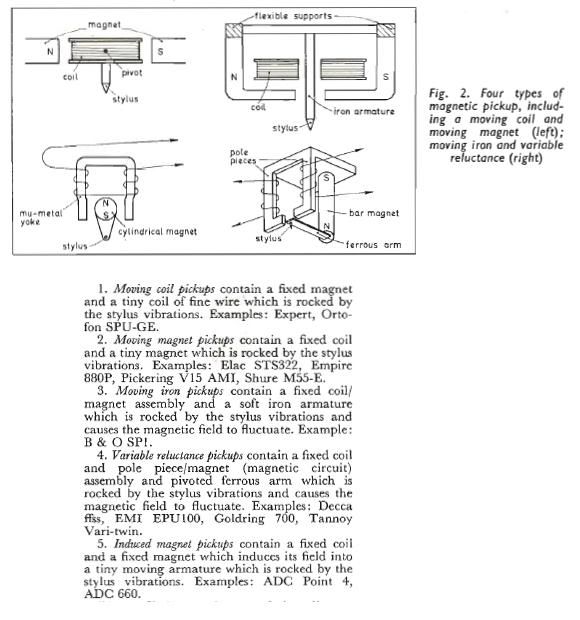Was looking at the SoundSmith line of moving iron cartridges ( bought the Sotto Voce) but haven't received it yet. Somewhere in my poking around and reading reviews Peter Ledman addressed this. In summary he posits the manufacturers have invested heavily in the tooling and touting of the moving coil superiority marketing, so they'd have to re-tool and eat crow about their marketing.
Peter's take on it, passes the sniff test for me.
|
The advantage of MI (moving iron over MM (moving magnet) is much lower coil inductance and lower moving mass. The result is faster transient response and wider bandwidth. Grado cartridges typically have coil inductance in the 10's of millihenries compared to the 100's of millihenries of MM's.
|
Moving iron allows for the lowest mass on the cantilever of all three traditional classes, making the cartridges very lively and dynamic. Put enough turns on the fixed coils and you can have the advantages of high output too (a simpler phono stage and less tendency to hiss). Peter Ledermann has admitted he only makes low output MI cartridges so that buyers can use their expensive MC phono stages with them. Don't forget that SS, Grado and Nagaoka employ a traditional cartridge design, utilising iron or an alloy of it as the only moving mass on the proximal end of the cantilever, but if you go to an older arrangement, that of the Decca "tip-sensing" cartridges, it is the thin iron armature that is the only moving mass, and it replaces the cantilever altogether. This allows the lateral coil to encircle the base of the stylus:

and the vertical coil sits right on top of the end of the armature holding the stylus:

No wonder their owners love them! I am pretty much all in on MI cartridges, with three of my four regular use cartridges being of this type. The fourth is a mono MC, and I sometimes wonder about getting a London Decca Maroon mono to replace it, but it comes with a conical stylus.
|
I have two modern Grado cartridges which I hold in high esteem.
The first is the Timbre Reference 3, and the other is their second from the very top, the AEON 3. The AEON 3 is on my greatly upgraded Linn LP12 and it will be there for a very long time to come.
|
Peter Ledermann has admitted he only makes low output MI cartridges so that buyers can use their expensive MC phono stages with them.
That’s a really interesting point, in favor of high-output MI (and MM). Since there’s NO moving mass penalty with regards to increased coil turns, the only potential cost to SQ would be in the signal going though more wire, and higher inductance. The advantages would lie in vastly simpler & easier phono amplification (less gain stages), and making the electronic noise floor drop away from consideration. In net, it seems almost silly to get a low-output MI cartridge? What would be the practical benefit to low output MI? It seemingly doesn’t make sense to buy a $multi-K LO-MI just because you wanted to reuse a LO-MC phono stage (extra gain stages) that (for some reason) didn’t have a switchable "just MM" mode.
|
|
@dogberry:
I believe the new owners of the London (Decca) brand will put a line contact stylus on the Maroon model (which comes with a spherical/conical) for an additional $268. I say that because I sent them my Model 4RC to be rebuilt, and they offered me that option.
While Grado and other moving iron designs share the moving iron element with Londons and Deccas, they sound nothing like the latter. J. Gordon Holt characterized the lack of a cantilever in the Deccas as resulting in a lack of "cantilever haze." If you've heard a direct-to-disk LP you have an idea of the startling immediacy and dynamic characteristics of the Decca/London design.
|
Peter L started out, I think, repairing B&O cartridges, which are all MI types, and the best of them can compete with any modern cartridge, IMO. That, I am guessing is how he got into the MI business. Even now he makes the SMMC line which is a reprise of the old B&O cartridges. Unfortunately, it does not appear that he can get the hollow sapphire tubular cantilevers of the old B&O MMC and MMC20CL series. That cantilever may be a key to the fantastic sonics of yore. I love MI cartridges and have yet to hear a bad one. All of mine are high output types.
|
I forgot to mention that the output voltage of Londons and Deccas is a very high 5mV! Schitt includes a 33dB gain setting specifically for Londons/Deccas on their Mani phono stage, 40dB on the Skoll and Stjama.
Some London/Decca enthusiasts like to run their pickups into a lower than standard 47k Ohm impedance. George Counnas of Zesto Audio told me he put a switchable setting of 15k Ohm in his Andros II phono stage at the behest of his industry friends who use Londons/Deccas in their personal systems.
|
Early in my audio sales journey I had the pleasure of meeting Peter Pritchard as he was launching the Sonus line of cartridges. Peter gave us a brief curriculum vitae tracing his work at GE Labs where he was on the team that developed the “variable reluctance” principle for phono cartridges…another name of MI. He left GE to found ADC in Connecticut where he adapted his ideas for stereo and reconfigured the VR arrangement with a patentable tubular soft iron generator, which he dubbed “induced magnet”. He also created a highly compliant suspension and relatively short cantilever…the ultimate expression being the XLM series. How Sonus materially differed from those is a mystery to me. His sale of ADC to BSR may have contained language allowing him to compete with them using his IP…I don’t know. But I do know that for a few years, the Sonus Blue Label and ADC ZLM were at the pinnacle of the MI cartridge world.
|
|
@bdp24 Glad to hear of the option for a line contact stylus with the Maroon. I lived happily with my Reference and Jubilee until I had to send my Reference back to John Wright for a rebuild. Learning that he was about to retire I started to explore other options hoping to find an MI cartridge that would sound like the Decca. I was surprised to find the MP-500 came closest. The Soundsmith cartridges I have are similar but praiseworthy for their own merits. The Grado Statement3 is the least like a Decca, to my ear.
I have never heard a Pickering or a Stanton. Nor any of the other now defunct MI cartridges.
|
Pickering and Stanton are MM, so far as I know. All of them.
|
I thought I had heard the term 'variable reluctance' applied to them? Which looks to me as if it a variant on the MI principle—see bottom right of this diagram from Gramophone in 1966:

|
Pickering is listed in the legend to your figure after point #2, as an example of "moving magnet". As I am sure you know, Pickering and Stanton were associated with each other. Most models of Pickering have a corresponding model among Stanton cartridges. Both companies marketed a low output MM, the Stanton 980LZS (also the 981 variant) and the Pickering XVS7500. These have a much lower inductance and internal R than do the typical high output MMs from anywhere. It IS interesting so see illustrated the differences among MI, variable reluctance, and induced magnet (IM) types. We usually don't bother to make a distinction among types 3, 4, and 5. For example, in this thread several refer to Decca as MI.
|
The drawing of the Decca/London pickup design on the new London site looks very similar to the drawing of the moving iron design in the Gramophone article. It’s the one in the upper right hand corner of fig. 2. The inclusion by the article’s author of the Decca in the variable reluctance category does not align with the description and drawing (bottom right corner) of a vr pickup in the article.
|
Variable reluctance refers to an operating principle, not a specific mechanical design. Here's a simple explanation -
Coils coupled to each of the magnetic circuits pick up flux changes which occur as a result of armature movement causing flux changes in the common gap.
|




